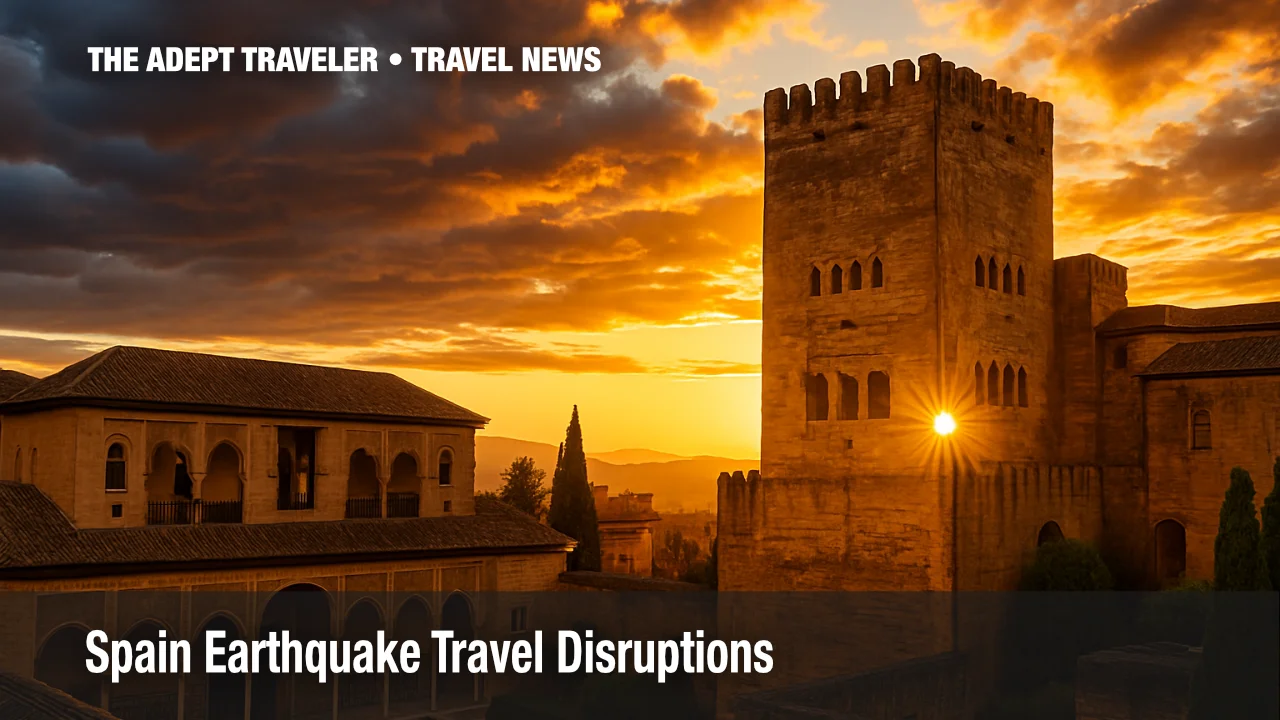Spain Earthquake Travel Disruptions: What Travelers Need to Know

A shallow, magnitude-5.4 - 5.5 earthquake struck the Western Mediterranean just offshore from Almería at 7:13 a.m. local time on July 14, 2025. The tremor jolted residents and visitors across Andalusia, Murcia, and parts of the Levante coast, prompting more than 30 emergency calls but no serious injuries. Rapid structural checks forced a short suspension of departures at Almería Airport (LEI), while rail and highway inspections caused sporadic delays. Historic sites-including the Alhambra in Granada-remain open after precautionary surveys found no damage. Aftershocks are possible through the week, and travelers should monitor official alerts.
Key Points
- Why it matters: July's peak-season itineraries face scattered delays across southern Spain.
- Almería Airport paused operations for safety checks; Madrid-Barajas, Barcelona-El Prat, and Málaga-Costa del Sol remain fully operational.
- No injuries or significant structural losses reported; landmark attractions report "business as usual."
- Mobile alerts and hotel briefings advise travelers to expect light aftershocks and review drop-cover-hold safety steps.
- Travel insurance covering trip interruption and alternate lodging is strongly recommended.
Snapshot * What Happened
The quake originated roughly 20 miles offshore of Cabo de Gata at a depth of about 1.2 miles, a configuration that transmits strong surface waves yet limits widespread destruction. Shaking intensity reached IV-V on the European Macroseismic Scale-enough to rattle objects and alarm sleepers but seldom topple modern buildings. Emergency managers activated Spain's seismic alert protocol, sent Android Early-Warning push notices, and placed coastal maremoto (tsunami) teams on standby before standing them down within an hour
Background * Spain's Seismic Hot Spots
Spain sits on the slow-moving boundary between the Eurasian and African plates. Most moderate quakes cluster in three zones: the Baetic Cordilleras (Granada-Almería), the Pyrenees, and Galicia. The Baetic segment produces Spain's most frequent damaging events, including the 5.1-magnitude Lorca quake in 2011. Today's offshore epicenter mirrors historical patterns-shallow, Mediterranean-based shocks that are widely felt yet rarely catastrophic thanks to Spain's updated building codes and civil-protection drills.
Latest Developments
Airports & Flights
- Almería (LEI): Departures paused for two hours while engineers inspected roof panels in the public concourse. Afternoon flights resumed on schedule, though passengers should confirm evening services and allow extra airport time for potential crowding.
- Network impact: No runway or air-traffic disruptions reported at Madrid-Barajas, Barcelona-El Prat, Málaga-Costa del Sol, or Seville. Airline change-fee waivers are limited to tickets touching Almería; contact carriers directly for rebooking.
Rail & Roads
- High-speed AVE and regional Media Distancia lines underwent mandatory track walks; trains now run with speed restrictions between Almería and Granada. Expect 15- to 30-minute residual delays through Tuesday.
- Andalusia's A-7 autovía and the N-340 coastal highway remained open after bridge and tunnel spot checks. Drivers should plan for slow-moving inspection zones if aftershocks occur.
Major Attractions
- Alhambra, Granada: Conservation staff conducted crack-gauging sweeps of the Nasrid Palaces and Generalife gardens. No fractures or displacements were recorded; tours proceed as scheduled.
- Mezquita-Cathedral, Córdoba & Alcazaba, Málaga: Routine safety walkthroughs cleared each site for visitors.
- Coastal beaches report normal operations, though lifeguard towers now broadcast aftershock guidance in Spanish and English.
Official Guidance Emergency number 112 remains the quickest way to reach police, fire, or medical help. Local authorities ask travelers to:
- Stay indoors and away from exterior walls during tremors.
- Expect additional mobile alerts if aftershocks exceed magnitude 3.0.
- Verify transport status before setting out; infrastructure teams will halt services automatically if sensors detect strong movement.
Analysis * What It Means for Travelers
The timing-early morning, shoulder of peak tourist traffic-helped minimize disruption. Still, ripple effects can linger: rental-car pickups bunch together after rail delays, small regional airports struggle with security-queue surges, and hotels near the epicenter may field overbookings as day-trippers decide to spend an unplanned night.
Travelers holding non-refundable reservations should review insurance clauses for "natural disaster" coverage and screenshot carrier waivers in case policies evolve. Those continuing to Granada, Málaga, or the Costa del Sol should pad itineraries with flexible transit windows and keep passports and a day's medication in quickly reachable bags.
The quake also underscores Spain's efficient emergency messaging-push alerts arrived within seconds for most Android users-yet many foreign visitors missed them because phones were on airplane mode or set to English-only system language. Enabling cellular roaming, Wi-Fi calling, and Spanish language packs improves the odds of receiving critical alerts.
Final Thoughts
Southern Spain's tourism infrastructure proved resilient, with only minor schedule shuffles and no closures at marquee sites. Keep monitoring official channels, reconfirm transport 24 hours before departure, and brush up on basic quake safety. With prudent flexibility, travelers can still enjoy Andalusia's palaces, beaches, and cuisine in the wake of the Spain earthquake travel disruption.
